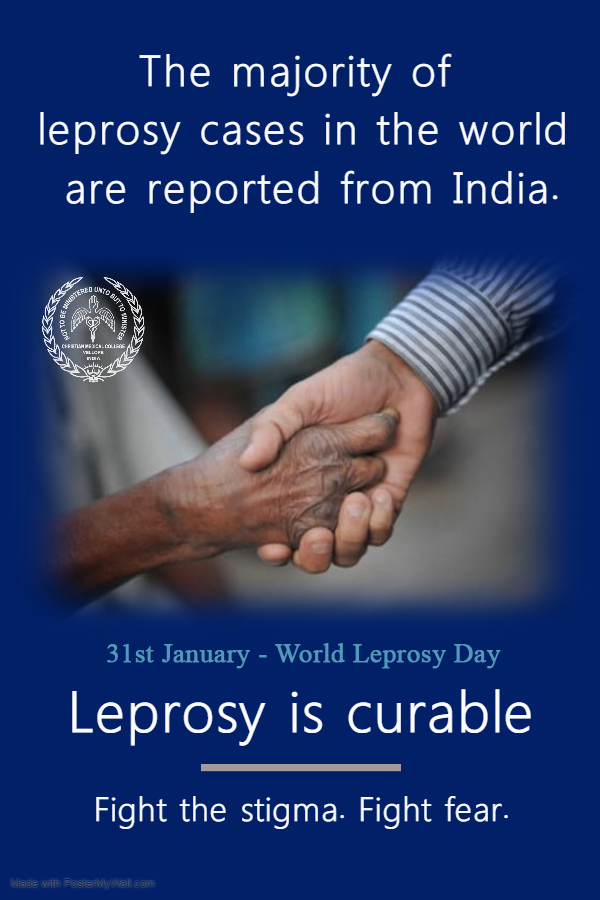Leprosy (Hansen’s Disease) is a chronic infection caused by bacteria. This disease was earlier thought to be incurable and people were kept in isolation. With modern medical management, now leprosy is COMPLETELY CURABLE though the stigma towards the disease still remains the same.
Mr. Prakasam, a recovered leprosy patient, is a happy father to three children and a trusted meat and egg-seller on campus.


Apart from the income he makes from this job, he also has his pension from CMC where he worked from a young age till his retirement at 60. "Though I suffered a lot as a child, I am now a happy man. I owe everything to the doctors and other members of the CMC community, who have looked after me in a hundred big and small ways throughout my life," he says with a smile brimming with confidence and contentment.
Dr. Paul Brand
 Dr. Paul Wilson Brand, pioneering leprosy researcher, worked with leprosy patients at CMC for many decades trying to understand how they contracted the disease and why it made fingers and toes vulnerable to the slightest injury and eventually disfigured and destroyed them.
Dr. Paul Wilson Brand, pioneering leprosy researcher, worked with leprosy patients at CMC for many decades trying to understand how they contracted the disease and why it made fingers and toes vulnerable to the slightest injury and eventually disfigured and destroyed them.
Dr. Brand was born in India in 1914. His early years were full of fun and adventure as he grew up in the Kolli Hills of Tamil Nadu. His caring parents welcomed everyone into their home. But one day this changed.
Read about Dr. Brand's early life and how the young Paul who had initially decided against Medicine as a career changed his mind and became a beacon of hope for hundreds of leprosy patients.
Read more about Paul Brand's work at CMC and how CMC continues to help patients of leprosy.
FAQs about leprosy
What causes leprosy?
Leprosy is caused by Mycobacterium leprae, which was discovered by Norwegian physician, Gerhard Henrik Armauer Hansen, in 1873. So, medically, the  disease is referred to as Hansen's disease. M. leprae multiplies slowly and the incubation period of the disease, on an average, is 5 years. Therefore the symptoms related to leprosy is usually very slow in onset and also progresses very slowly.
disease is referred to as Hansen's disease. M. leprae multiplies slowly and the incubation period of the disease, on an average, is 5 years. Therefore the symptoms related to leprosy is usually very slow in onset and also progresses very slowly.
The disease mainly affects the skin, the peripheral nerves, mucosa of the upper respiratory tract, and the eyes.
Symptoms of Leprosy
Early symptoms begin in the cooler areas of the body - areas close to the skin, superficial nerves, eyes and nose - and include loss of sensation. Signs of leprosy are painless ulcers, hypopigmented macules (flat, pale areas of skin) and eye damage (dryness and reduced blinking).
 Depending upon the status of the immune system of the body, it may present either as few patches with decreased sensation, involving a few nerves or in a few, may present as numerous patches with thickening of most of the peripheral nerves.
Depending upon the status of the immune system of the body, it may present either as few patches with decreased sensation, involving a few nerves or in a few, may present as numerous patches with thickening of most of the peripheral nerves.
If there is good immunity, symptoms will be limited to one area. The involvement of peripheral nerves may cause loss of sensation or weakness of muscles leading to loss of function of hands and feet.
It may also cause sudden increase in the number of patches or redness and swelling of the existing patches, fever, rash, painful swellings or swelling of hands and feet, painful joints, bone pain, redness of eyes, sudden loss of sensation of one area or weakness of the limbs.
How does leprosy spread? Does it spread by touching leprosy patients?
Leprosy does not spread through touch. It is spread mainly through long-term contact with an affected individual, via droplets, from the nose and mouth, during close and frequent contact with untreated cases.
How is leprosy diagnosed?
Leprosy is usually suspected based on the symptoms and signs but needs to be confirmed by doing slit skin smears and by biopsy of affected skin or nerve when there are only few lesions.

Is leprosy curable?
Leprosy is completely curable with multidrug therapy (MDT). The treatment is extremely effective and can put a stop to the progression of the disease.
How is leprosy treated?
The bacteria that cause leprosy have gradually become resistant to single-drug treatments; therefore, the recommended treatment is a combination of two or more anti-leprosy drugs. Leprosy is treated with combinations of drugs such as dapsone, rifampicin and clofazimine for 12 months.
Alternate drugs like Ofloxacin, Clarithromycin and minocycline are used if the disease is resistant to primary drugs. It is very important to diagnose the disease early in order to properly treat it and prevent complications.
To make sure that the disease is adequately treated, supervised drugs are given once a month by a doctor. When there is an acute inflammatory response – painful, red swelling, which is warm to the touch - in the course of the disease due to change in the immunity, which is a common cause of nerve damage, it is commonly controlled with drugs like prednisolone and thalidomide.
It is also important to screen the family members of leprosy patients so that early detection and treatment of the disease can prevent deformities.
What happens if leprosy is not treated?
Untreated, leprosy can cause progressive and permanent damage to the skin, nerves, limbs, and eyes.
Key message: LEPROSY – COMPLETELY CURABLE. NO ‘UNTOUCHABILITY’.
Common doubts about leprosy answered
Can I get leprosy if I shake hands with a leprosy patient?
No
Can sitting next to someone with leprosy give you leprosy?
No
Can a pregnant mother with leprosy pass on the disease to her unborn child?
No
Can I get leprosy if I have sex with a leprosy patient without being aware of his/her illness?
No
Is leprosy curable?
Yes, completely.
How early should I start treatment if the doctor has told me I have leprosy?
Treatment should be started as soon as you are diagnosed with leprosy.
Does leprosy always cause my hands and feet to be damaged?
With immediate diagnosis and treatment, leprosy need not ANY damage to your hands and feet.
If my hands and feet become damaged, will they ever become normal again?
Unfortunately, no. If the hands and feet have become disfigured, they cannot regain their old shape.
Does a leprosy patient have leprosy from birth? or does it happen suddenly later in life?
Leprosy is not a disease you have from birth but a person can get the disease at any time during his lifetime.
Does leprosy spread?
Yes, but not fast and not easily. Only with a lot of contact with a leprosy patient over many years is there a risk of getting leprosy.
How does leprosy actually spread?
Normal, healthy people get leprosy only if they are exposed to the droplets from the nose and mouth of a leprosy patient over many years.
If I have a white patch on my face, does that mean I may have leprosy?
It is best to go to a skin doctor, in the department of Dermatology, to first get it checked out.
How do I make an appointment at CMC to see a skin doctor?
To make an appointment with our Department of Dermatology, click here. To read about the various services offered in the department and the doctors available to see you, click on Dermatology under D in this list.
Does leprosy affect men or women more?
Leprosy is not a woman’s disease or a man’s disease. It can affect both men and women.
Does leprosy affect young people or old people more?
Leprosy can affect anyone, irrespective of whether they are young or old.
Why do Western countries have less leprosy cases than we have?
Western countries have no cases of leprosy because of better treatment and better awareness over many decades.
If my child has leprosy, should I stop sending him to school?
If you child has leprosy, first and foremost take him to a doctor to start treatment. Then after consulting with your doctor, you can decide about matters related to school.
Is leprosy painful?
A leprosy patient does not feel pain. That is the biggest problem of leprosy. A patient can have wounds or injuries and be completely unaware of it.
But hasn't leprosy already been eradicated?
In 2005, the World Health Organisation had declared that leprosy was completely eliminated based on the fact that the rates of occurrence had become 1 in 10,000 across a larger population. However, since then the number of patients have increased significantly.
How do we get rid of leprosy once and for all?
If we remove the shame and stigma surrounding leprosy, we can go a long way towards eliminating leprosy because more people will then come forward to get help and treatment. If we create more awareness about how leprosy spreads, we can reduce the rates of transmission. Finally, we have to take active steps to protect the poor who are the most vulnerable. Such efforts over a long time will help us be rid of leprosy once and for all.